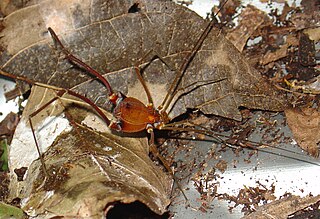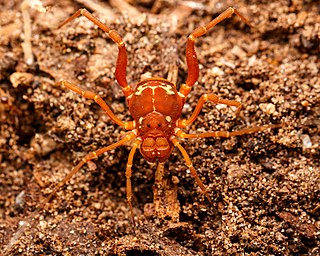
Pachylinae is the most diverse subfamily of the harvestman family Gonyleptidae, including around 400 valid species. Major groups of species occur in the Brazilian Atlantic forest, Bolivian/Peruvian highlands, Argentina and Chilean temperate forest.

Gonyleptoidea is the most diverse superfamily of the Grassatores. It includes around 2,500 species distributed in the Neotropics. They are characterized by the simplified male genitalia, with the glans free subapical in the truncus.

Samooidea is a large superfamily in the Grassatores group of harvestmen. It includes around 380 species distributed throughout the tropics. They are characterized by the complex male genitalia, with eversible complementary sclerites.

Cosmetidae is a family of harvestmen in the suborder Laniatores. With over 700 species, it is one of the largest families in Opiliones. They are endemic of the New World with a Nearctic-Neotropical distribution where a large fraction of the diversity of Opiliones are represented by this single family. Cosmetidae have the northern extent of their range into the USA, where a small number species occur in the southern states. However, the family is especially diverse in Mexico, Central America and northern South America; especially the Andean realms. Their range also extends further south into Argentina and southern Brazil, but they are absent in Chile. Cosmetidae are prevalent in Amazonian region, but only relatively few also occur in Brazilian Atlantic Forest. Several species are also found in the Caribbean.

The Sclerosomatidae are a family of harvestmen with about 1,300 known species. One former subfamily has been recently removed to form a new family, Globipedidae.

Epedanidae is a family of the harvestman infraorder Grassatores with about 200 described species. They are the sister group of the Gonyleptoidea.
Agoristenidae are a neotropical harvestman family of the Suborder Laniatores, in the superfamily Gonyleptoidea.
The Manaosbiidae are a family of neotropical harvestmen within the suborder Laniatores.

The Cranaidae are a family of neotropical harvestmen within the suborder Laniatores.
Cosmetinae is a subfamily of harvestmen in the family Cosmetidae.

Cynorta is a genus from the subfamily Cynortinae. The genus was first described by Carl Ludwig Koch.
Taito is a genus of harvestmen in the family Cosmetidae. The genus is endemic to the Amazon Basin in Brazil, Colombia, Ecuador and Peru.
Rhaucus is a genus of harvestmen in the family Cosmetidae. The genus is endemic to the Colombian northern Andes. There are currently seven described species in the genus.

Cynortinae is a subfamily of harvestmen in the family Cosmetidae.
Discosomaticinae is a subfamily of harvestmen in the family Cosmetidae.
Ferkeriinae is a subfamily of harvestmen in the family Cosmetidae.
Flirteinae is a subfamily of harvestmen in the family Cosmetidae.
Libitiinae is a subfamily of harvestmen in the family Cosmetidae.
Metergininae is a subfamily of harvestmen in the family Cosmetidae.








